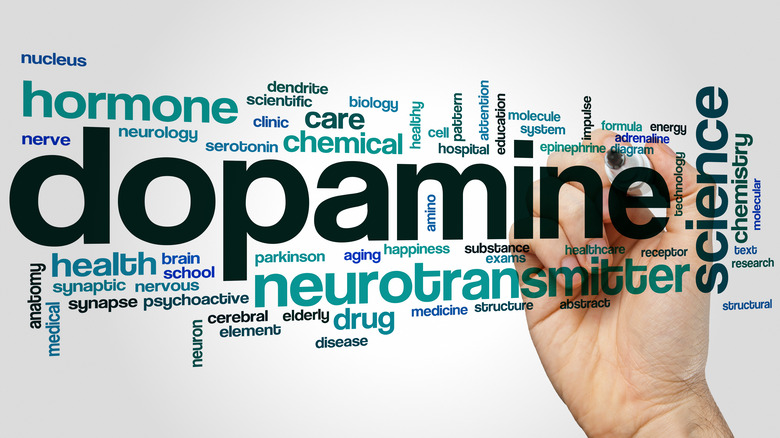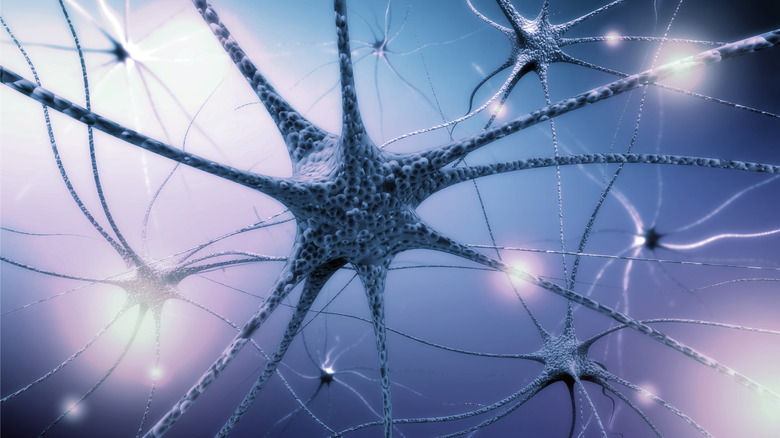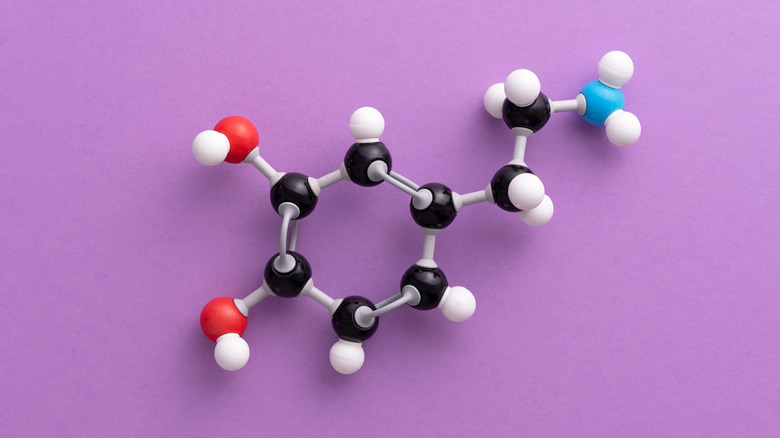Everything You Wanted To Know About Dopamine
Dopamine is an important brain chemical that has various roles. Perhaps most famously, it functions as a neurotransmitter — often referred to as the "feel-good" hormone by researchers (via Journal of Neuroscience and Neuropharmacology). It plays a crucial role in the brain's "reward center," as well as facilitating movement, learning, lactation, sleep, memory formation, and more.
Outside of the brain, dopamine serves as a hormone (via ResearchGate). Released by the adrenal glands into the bloodstream, it helps activate the "fight or flight" response. This prepares your body for danger so that it's ready to tackle or escape a stressful or threatening situation.
Out of whack dopamine levels are associated with a host of mental and physical issues. Too much dopamine can lead to schizophrenia or spark mania, whereas too little might be at the root of a neurodegenerative disorder called Parkinson's disease (via Translational Psychiatry). Dopaminergic dysfunction may also underlie a number of other psychiatric disorders, including autism, depression, anorexia, attention-deficit hyperactivity disorder (ADHD), and obsessive-compulsive disorder (OCD).
Scientists have come a long way to understanding the nature and function of dopamine (via Frontiers in Psychiatry). There's a lot yet to unravel. Here are some things we currently know about this important neurotransmitter and how it works in your body and brain.
Dopamine's pleasure role
Dopamine is often mistakenly dubbed the "pleasure" hormone (via Neurotoxicity Research). Over the years, it's been associated with feelings of euphoria and bliss. More accurately, however, dopamine is released during satisfying activities like when we eat our favorite foods or have sex. It encourages us to repeat a specific behavior or to pursue a particular substance by creating a reward circuit in the brain. In other words, dopamine is a "motivation" chemical — it teaches us to "want" a rewarding experience or sensation.
Research shows that dopamine plays a role in various other important bodily functions, too (via Oxidative Medicine and Cellular Longevity). It's involved in feelings of punishment and shame, voluntary movement, mood regulation, behavior and cognition, inhibition of prolactin secretion, and sleep and dreaming.
We can learn a lot about the different functions of dopamine by looking at the symptoms of Parkinson's disease, which is a neurodegenerative disorder whereby the dopamine-producing neurons in the brain start to deteriorate, causing a chronic lack of dopamine. This gradually results in memory loss, tremors and stiffness, difficulty walking and balancing, and speech problems (via Frontiers in Psychology).
Its role in avoidance
While dopamine is widely known for directing us toward satisfying goals, the messenger substance is also responsible for avoidant behaviors, according to a study published in Current Biology. Dopamine drives aversive responses that may stem from fear and pain. Specifically, the release of dopamine in the nucleus accumbens is what motivates us to shun experiences and stimuli that we consider to be unpleasant or threatening — just as it compels us to seek out exciting and pleasurable ones.
The study highlights the mysterious role of endocannabinoids in avoidant behavior. These are neurotransmitters that are similar to cannabinoids (compounds found in the marijuana plant) but are naturally produced by the body. The researchers found that endocannabinoids activate dopamine neurons during avoidance responses, which might help reinforce these behaviors over time.
The findings are supported by the types of symptoms that tend to accompany psychiatric illnesses like depression and post-traumatic stress disorder (PTSD), explain the researchers. These conditions are both characterized by an inability to avoid a sense of anxiety, a sort of hopelessness and resignation. And people struggling with these disorders usually have abnormally reduced levels of dopamine.
Neurotransmitters
Important brain chemicals like dopamine are called neurotransmitters (via the Cleveland Clinic). As the name describes, their job is to transport chemical messages between neurons (nerve cells) and target cells throughout the body, such as in muscles, glands, and other neurons. There are roughly 100 different known neurotransmitters, but scientists suspect there are many more to be discovered (via Introduction to Psychology).
In order to carry and receive signals across your nervous system, a neurotransmitter binds to a specific receptor — a bit like a key fitting into a lock (via Introduction to Psychology). Once bound, the neurotransmitter triggers various changes in the receiving cell, causing an action or series of events in the body.
Billions of neurotransmitters work together to keep everything running smoothly from your breath to your heartbeat to the movement of your limbs. Your body can't function without them. Neurotransmitters have various jobs and functions depending on the region in which it specializes, according to research in the National Library of Medicine. For example, in your brain's movement center, dopamine controls different types of movement, and in the learning region, it may deal with attention or working memory.
The production of dopamine
Dopamine is produced in several parts of the brain, including the substantia nigra and the ventral tegmental area (via Oxidative Medicine and Cellular Longevity). To sum it up: The enzyme tyrosine hydroxylase converts the amino acid tyrosine to l-dopa, which is then metabolized to dopamine by aromatic amino acid decarboxylase (via Archives of Biochemistry and Biophysics).
The amino acid tyrosine is one of the 20 building blocks of protein in your body (via WebMD). It's a non-essential amino acid, which means your body can produce it, even if you don't get it from the food you eat. Needless to say, it's also possible to boost your tyrosine levels via your diet. Foods that are high in tyrosine include protein-rich foods, such as soybeans, nuts, fish, sesame seeds, and dairy products.
Research shows that increasing the amount of tyrosine in your body can raise your dopamine levels (via Psychological Research). In turn, this may promote better cognitive functioning and mental performance, including better working memory and more flexible thinking.
Drugs that affect dopamine
Various drugs affect dopamine transmission either by blocking or stimulating its receptors in the brain. For example, antipsychotic drugs work by binding to and blocking dopamine receptors (via Current Topics in Medicinal Chemistry). These are called dopamine antagonists and they're often used to treat psychiatric conditions like schizophrenia and bipolar disorder by dialing down dopamine activity.
Recreational drugs like cocaine and amphetamines cause the dopamine in your brain to shoot up, per research (via Clinical Psychopharmacology and Neuroscience). It does this by attaching to the dopamine transporter and preventing the recycling of dopamine, which causes large amounts of it to build up in the space between two cells (also known as the synapse).
Nicotine and alcohol also increase dopaminergic firing in the brain's reward center by disrupting the communication between neurons (via Current Addiction Reports). Some drugs like marijuana contain chemicals that mimic natural neurotransmitters, which indirectly amp up dopamine levels in the brain, according to a study in Nature.
Dopamine's role in addiction
Dopamine's reinforcing effects ensure that we learn to repeat certain activities without thinking about them — some of which may be integral to our survival (via Annual Review of Psychology). For example, dopamine is released when we do something essential like eating, which links that activity to feeling good. The brain is then compelled to repeat that activity again and again in order to experience a similar sense of reward and satisfaction. This is how behaviors become habits or addictions.
However, repeatedly using a dopamine-inducing substance can hijack the brain's reward system and change its neuroplasticity over time (via National Institute on Drug Abuse). In response to repeated surges of dopamine, the brain's dopamine receptors gradually start to plummet. As a result, the substance becomes less rewarding and has less of an impact than it originally did (the effect is called "tolerance"). The individual may find themselves wanting more and more of the substance in order to feel good or even somewhat normal. Continuing to use an addictive substance or repeat an addictive behavior simply keeps the individual locked in a vicious cycle of craving and addiction.
Areas of the brain affected by dopamine
When dopamine is released in the brain, it influences various regions (via Nature). The two areas that are most affected are the motor cortex and the insular cortex (also known as the insula), per the McGovern Institute.
Dopamine plays an important role in the brain's motor cortex, where it helps your muscles move in a smooth and coordinated way (via Medical News). Loss of dopamine neurons and low levels of dopamine in this part of the brain has been linked to several motor-related conditions, in particular, Parkinson's disease.
It's often overlooked that dopamine also exerts its effects on the insula. This remote brain region is involved in various functions: Sensory perception and processing, conscious awareness, somatosensory perception, autopilot functioning, and switching between cognitive activities like planning, thinking, and feeling (via Neurology). Dysfunctional dopaminergic activity in this area is thought to be responsible for the many non-motor symptoms associated with Parkinson's disease (via Brain). This includes sensory hypersensitivity, chronic pain, difficulty regulating body temperature, loss of bladder control, and mood problems like anxiety and depression.
The four major dopamine pathways
The four main dopaminergic pathways in the brain include the mesolimbic, mesocortical, nigrostriatal, and tuberoinfundibular systems (via Psych Scene Hub). These are a series of neuronal connections which allow dopamine to hop from one part of the brain to another. They help carry important signals that facilitate different modes of functioning, such as thinking, motivation, and voluntary motor movements.
The mesolimbic pathway is involved in the very thing that dopamine is known for: A sense of reward and satisfaction. Activation of this pathway helps motivate us and reinforce certain behaviors, but it can also give rise to cravings and addiction when overstimulated.
The mesocortical pathway is where cognition, working memory, and decision making occur. Decreased dopaminergic activity in this pathway is said to account for the cognitive impairments and symptoms associated with schizophrenia.
The nigrostriatal pathway is involved in motor planning and bodily movements. Lack of activity or hyperactivity of dopamine in this pathway can lead to motor-related problems, such as dystonia and Parkinsonian symptoms.
Finally, the tuberoinfundibular pathway inhibits the release of prolactin — a protein that enables milk production in women. Dysfunction in this specific pathway can take its toll on metabolism, sexual satisfaction, and immunity.
The death of neurons in either one of the dopamine pathways can manifest in various mental, physical, and cognitive diseases, such as, in people with Parkinson's disease.
Causes of low dopamine
Numerous factors can lead to low levels of dopamine in the brain, including substance abuse and addiction (via Nature Reviews Neuroscience). Unsurprisingly, your diet is another possible culprit. Palatable foods can cause dopamine levels to spike, which is why eating foods that are high in saturated fats can be temporarily pleasurable. But consuming a high-fat diet, over time, can disturb the workings of the dopamine system, leading to a dopamine deficiency in the long-term, according to a study in eNeuro.
Dopamine is what helps us feel perky and energized, according to research (via Frontiers in Cellular Neuroscience). Your brain secretes more dopamine in the mornings when you wake up, creating feelings of alertness. Its production then naturally decreases throughout the day, making it easier for you to fall asleep when bedtime comes around. However, sleep deprivation reduces the number of dopamine receptors in the brain, disrupting the transmission and production of dopamine (via Journal of Neuroscience). This explains why people feel groggy and mentally depleted after a sleepless night.
Stress can also take a toll on your dopamine system (via eLife). The brains of people who are chronically exposed to psychosocial trauma and adversity become less able to produce dopamine. This in turn negatively affects individuals' ability to cope with stressful situations in the future. Under stress, the body breaks down dopamine to produce hormones like oxytocin, which can drain dopamine reserves in the long term (via European Business Review).
Consequences of low dopamine levels
Inadequate dopamine levels can produce various symptoms, ranging from mild to life-altering (via Molecular Neurobiology). These manifest differently in people, depending on many different factors like lifestyle and genetics. Hypodopaminergic individuals may have trouble concentrating, remembering things, managing day-to-day tasks, solving basic cognitive problems, or achieving their goals.
A lack of motivation and the inability to enjoy previously pleasurable activities are tell-tale signs of dopamine deficiency, note researchers (via The International Journal of Neuropsychopharmacology). These symptoms often accompany depression and other mood disorders.
Individuals struggling with problematic eating behaviors and depressive symptoms often have low dopamine, which causes them to seek out food as a way to self-medicate and numb negative emotions (via Appetite). People with obesity tend to have impairments in their dopaminergic pathways (via Trends in Cognitive Sciences).
Low dopamine can also trigger a loss of balance and coordination, reports a study published in Frontiers in Aging Neuroscience. As dopamine levels continue to drop, some people find it hard to control their voluntary movements — as is the case in people with Parkinson's disease.
A dysfunctional dopamine system is also believed to contribute to restless leg syndrome (RLS), where people have a strong urge to move their legs (via Frontiers in Neurology). Symptoms tend to worsen toward the evening, which is when dopamine levels naturally fall. Dopamine agonists are used to treat RLS. These medications activate dopamine receptors and trick your brain into thinking that it's receiving dopamine.
Too much dopamine
As the saying goes, you can have too much of a good thing. And dopamine is no exception. Research shows that besides driving addiction, an overactive dopamine system can cause impulse-control problems, such as compulsive sexual behavior, also known as hypersexuality (via Neuropsychopharmacology).
Dopamine can give your brain and body a kick, but it can also create overstimulation, setting off behavioral issues like aggression and impulsivity. Researchers found that when dopamine is released in high amounts, aggressive behavior heightens, and when the dopamine pathway is blocked, aggression appears to subside (via Nature Communications). High-dopamine individuals tend to be less empathetic and caring, and more masculine and competitive in their behaviors (via Molecular Neurobiology).
An excess of dopamine is also believed to be at the root of schizophrenia (via World Psychiatry). It's hypothesized that there may be too many dopamine receptors in the brain, triggering some of the positive symptoms associated with the disorder, including hallucinations, delusions, and psychosis. On the other hand, negative symptoms like apathy, social withdrawal, and an inability to feel pleasure may stem from low dopamine. The condition is generally treated and managed with medication that blocks the brain's dopamine receptors (via Cochrane Database of Systematic Reviews).
Dopamine can help identify emotions
Poor emotion recognition might be another major side effect of dwindling dopamine in the brain (via Journal of Neuroscience). This often shows up in people with neurological disorders such as schizophrenia or Parkinson's disease. Patients typically have poor social functioning, including difficulty expressing themselves, weak communication skills, and an inability to read social cues or pick up on other people's emotions.
The 2022 study found that when patients with low dopamine took haloperidol — an antipsychotic drug that treats schizophrenia by leveling out dopamine — their ability to identify emotions in others improved (per Journal of Neuroscience). The study said, "Effects of haloperidol on emotion recognition depended on baseline dopamine function, where individuals with low baseline dopamine showed enhanced, and those with high baseline dopamine decreased emotion recognition." And so, patients with high dopamine levels became worse at recognizing emotions after taking the medication.
"Individuals with low baseline dopamine also slowed their own walking pace under haloperidol, and so we think the effects of the drug on movement and emotion recognition are connected," lead study author Bianca Schuster told ScienceDaily, adding: "It is not yet clear, however, why the drug actually impaired emotion recognition in the participants with high baseline dopamine. It's likely that timing and movement are not the only mechanisms that are important."
Here are some ways to increase dopamine
Luckily, there are quite a few ways to bring your dopamine levels back to life. Medication is commonly used where depleted dopamine levels are attributed to a specific illness like depression or schizophrenia (via Health Direct). But it's also possible to top up your dopamine naturally by implementing positive lifestyle changes. For instance, meditation can help lift dopamine levels, contributing to dopaminergic neurogenesis over time (via Scientific Reports). Regular exercise has also been shown to increase dopamine in the brain, according to the Journal of Neuroscience. Engaging in pleasurable activities like getting a massage or listening to music are simple and gentle ways to restore a dopamine deficiency in your day-to-day life (via Nature Neuroscience).
You can also replenish your dopamine pool by following a healthy diet, namely cutting down on high-fat foods and processed sugars. On the other hand, foods that are high in tyrosine (the precursor of dopamine) are a good choice for those who are low on dopamine — as are omega-3 fatty acids, according to research (via Bentham Science).
Finally, a powerful strategy to protecting your dopamine stores is to avoid and reduce stress as much as possible, according to a study (via Neuroscience). We can't control everything that happens in our lives, but we can get rid of unnecessary stressors within our control and adjust the way that we respond to and cope with stressful situations.














